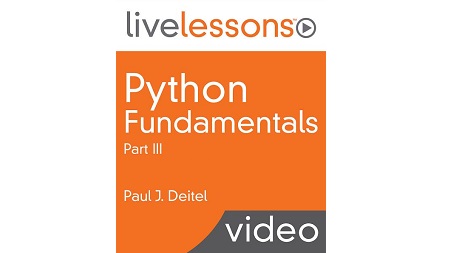
English | MP4 | AVC 1280×720 | AAC 44KHz 2ch | 3h 47m | 2.03 MB
The professional programmer’s Deitel® video guide to Python development with the powerful IPython and Jupyter Notebooks platforms.
Python Fundamentals LiveLessons with Paul Deitel is a code-oriented presentation of Python–one of the world’s most popular and fastest growing languages. In the context of scores of real-world code examples ranging from individual snippets to complete scripts, Paul will demonstrate coding with the interactive IPython interpreter and Jupyter Notebooks. You’ll quickly become familiar with the Python language, its popular programming idioms, key Python Standard Library modules and several popular open-source libraries. In the Intro to Data Science videos, Paul lays the groundwork for later lessons in which he’ll introduce some of today’s most compelling, leading-edge computing technologies, including natural language processing, data mining Twitter® for sentiment analysis, cognitive computing with IBM® Watson™, supervised machine learning with classification and regression, unsupervised machine learning with clustering, computer vision through deep learning and convolutional neural networks, sentiment analysis through deep learning with recurrent neural networks, big data with Hadoop®, Spark™ streaming, NoSQL databases and the Internet of Things.
What you will learn in Part III:
- Lesson 8—Strings: A Deeper Look—String methods; string formatting; concatenating and repeating strings; stripping whitespace; string comparisons; search strings for substrings and replacing substrings; tokenizing strings; regular expressions for pattern matching, replacing substrings and validating data; manipulating data in pandas.
- Lesson 9—Files and Exceptions—Text-file processing; serializing objects into the JSON with the json module; with statement for avoiding “resource leaks”; exception handling; try…except statement; else clause; executing code when no exceptions occur in a try suite; finally clause; raise exceptions; more details on tracebacks; stack unwinding; CSV file processing via the csv module; loading and manipulating CSV files in pandas.
- Lesson 10—Object-Oriented Programming—Custom classes; controlling access to attributes; properties for data access; simulating “private” attributes; Python special methods for customizing string representations; inheritance, duck typing and polymorphism; class object; Python special methods for overloading operators; named tuples; Python 3.7 data classes; unit testing with doctest; namespaces and how they affect scope; Introduction to time series and simple linear regression.
Table of Contents
1 Introduction to Python Fundamentals – Part 3
2 Lesson overview
3 Formatting Strings–Presentation Types
4 Self Check
5 Formatting Strings–Field Widths and Alignment
6 Self Check
7 Formatting Strings–Numeric Formatting
8 Self Check
9 Formatting Strings–String’s format Method
10 Self Check
11 Concatenating and Repeating Strings
12 Self Check
13 Stripping Whitespace from Strings
14 Self Check
15 Changing Character Case
16 Self Check
17 Comparison Operators for Strings
18 Searching for Substrings
19 Self Check
20 Replacing Substrings
21 Self Check
22 Splitting and Joining Strings
23 Self Check
24 Characters and Character-Testing Methods
25 Raw Strings
26 Introduction to Regular Expressions
27 re Module and Function fullmatch Part 1–Matching Literal Characters
28 re Module and Function fullmatch Part 2–Metacharacters, Character Classes and Quantifiers
29 re Module and Function fullmatch Part 3–Custom Character Classes
30 re Module and Function fullmatch Part 1–Quantifiers
31 Self Check
32 Replacing Substrings and Splitting Strings
33 Self Check
34 Other Search Functions; Accessing Matches–Function search – Finding the First Match Anywhere in a String
35 Other Search Functions; Accessing Matches–Ignoring Case with the Optional flags Keyword Argument
36 Other Search Functions; Accessing Matches–Metacharacters that Restrict Matches to the Beginning or End of a String
37 Other Search Functions; Accessing Matches–Functions findall and finditer – Finding All Matches in a String
38 Other Search Functions; Accessing Matches–Capturing Substrings in a Match
39 Self Check
40 Intro to Data Science – Pandas, Regular Expressions and Data Munging Part 1 – Introduction
41 Intro to Data Science – Pandas, Regular Expressions and Data Munging Part 3 – Data Validation
42 Intro to Data Science – Pandas, Regular Expressions and Data Munging Part 4 – Reformatting Your Data
43 Self Check
44 Lesson overview
45 Files
46 Text-File Processing–Writing to a Text File – Introducing the with Statement
47 Self Check
48 Text-File Processing–Reading Data from a Text File
49 Self Check
50 Updating Text Files
51 Self Check
52 Serialization with JSON–JSON Data Format
53 Serialization with JSON–Serializing an Object to JSON
54 Serialization with JSON–Deserializing a JSON Object into Python
55 Serialization with JSON–Displaying JSON Text
56 Self Check
57 File Open Modes
58 Handling Exceptions
59 Division by Zero and Invalid Input
60 try Statements
61 Self Check
62 finally Clause
63 Self Check
64 Explicitly Raising an Exception
65 Stack Unwinding and Tracebacks
66 Intro to Data Science – Working with CSV Files–Python Standard Library Module csv
67 Self Check
68 Intro to Data Science – Working with CSV Files–Reading CSV Files into Pandas DataFrames
69 Intro to Data Science – Working with CSV Files–Reading the Titanic Disaster Dataset
70 Intro to Data Science – Working with CSV Files–Simple Data Analysis with the Titanic Disaster Dataset
71 Intro to Data Science – Working with CSV Files–Passenger Age Histogram
Resolve the captcha to access the links!